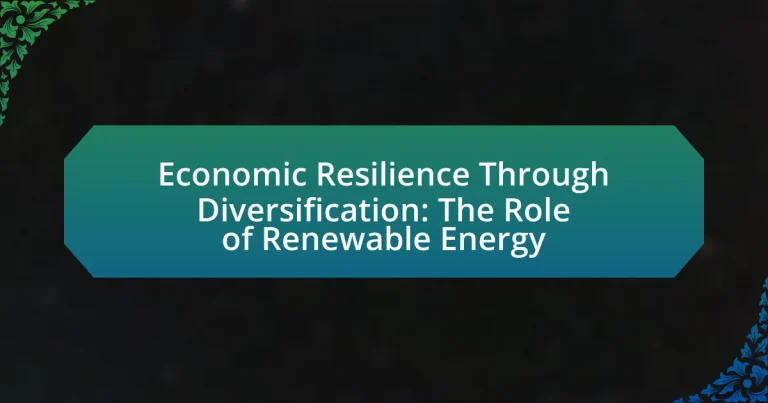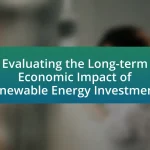Economic resilience through diversification, particularly in the context of renewable energy, refers to an economy’s ability to withstand and recover from shocks by integrating various renewable energy sources. This approach enhances stability and adaptability by reducing dependency on a single energy source, thereby mitigating risks associated with price volatility and supply disruptions. The article explores how diversification contributes to economic resilience, the key elements involved, and the role of renewable energy in reducing reliance on fossil fuels. It also addresses the challenges faced by renewable energy sources, the importance of supportive policies, and the potential for job creation and economic growth through the adoption of renewable technologies. Additionally, it highlights future trends and practical steps individuals can take to support economic resilience through renewable energy initiatives.
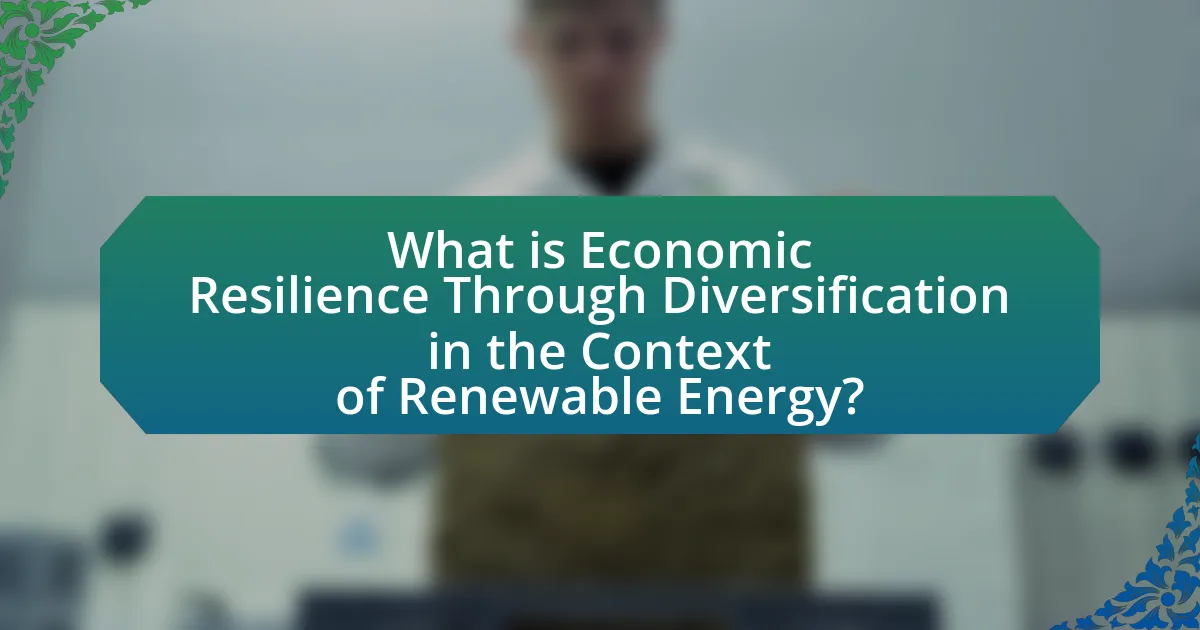
What is Economic Resilience Through Diversification in the Context of Renewable Energy?
Economic resilience through diversification in the context of renewable energy refers to the ability of an economy to withstand and recover from shocks by integrating a variety of renewable energy sources. This approach reduces dependency on a single energy source, thereby enhancing stability and adaptability in energy supply. For instance, countries that invest in solar, wind, and hydroelectric power can mitigate risks associated with price volatility and supply disruptions in fossil fuels. Research indicates that economies with diversified energy portfolios experience less severe impacts during energy crises, as evidenced by the International Renewable Energy Agency’s findings that nations with a mix of renewable sources have shown greater energy security and lower greenhouse gas emissions.
How does diversification contribute to economic resilience?
Diversification contributes to economic resilience by reducing dependency on a single sector, thereby mitigating risks associated with market fluctuations. When economies diversify, they spread investments across various industries, which can buffer against downturns in any one sector. For instance, during the 2008 financial crisis, countries with diversified economies, such as Canada, experienced less severe impacts compared to those reliant on a single industry, like Greece, which faced significant economic challenges due to its dependence on tourism and shipping. This illustrates that a diversified economic structure enhances stability and adaptability, allowing for a more robust response to external shocks.
What are the key elements of economic resilience?
The key elements of economic resilience include diversification, adaptability, and robust infrastructure. Diversification allows economies to reduce dependency on a single sector, thereby mitigating risks associated with market fluctuations. Adaptability refers to the ability of economic systems to adjust to changes, such as technological advancements or shifts in consumer preferences, which enhances long-term sustainability. Robust infrastructure, including transportation, energy, and communication systems, supports economic activities and enables quick recovery from disruptions. These elements collectively strengthen an economy’s capacity to withstand shocks and maintain stability, as evidenced by studies showing that diversified economies recover faster from recessions compared to those reliant on a narrow range of industries.
How does renewable energy fit into the diversification strategy?
Renewable energy is integral to diversification strategies as it reduces dependence on fossil fuels and enhances energy security. By incorporating renewable sources like solar, wind, and hydro, organizations and nations can mitigate risks associated with price volatility and supply disruptions in traditional energy markets. For instance, countries that have invested in renewable energy have seen a decrease in energy import costs and an increase in local job creation, contributing to economic stability. According to the International Renewable Energy Agency, the renewable energy sector employed over 11 million people globally in 2018, demonstrating its potential to bolster economic resilience through diversification.
Why is renewable energy important for economic stability?
Renewable energy is crucial for economic stability because it reduces dependence on volatile fossil fuel markets, thereby stabilizing energy prices. By diversifying energy sources, economies can mitigate risks associated with price fluctuations and supply disruptions. For instance, countries that invest in renewable energy technologies, such as solar and wind, often experience lower energy costs over time, as these sources become more cost-effective and less susceptible to geopolitical tensions. According to the International Renewable Energy Agency (IRENA), the global renewable energy sector employed over 11 million people in 2018, demonstrating its potential to create jobs and stimulate economic growth. This job creation further enhances economic resilience by providing stable employment opportunities in various regions.
What role does renewable energy play in reducing dependency on fossil fuels?
Renewable energy significantly reduces dependency on fossil fuels by providing alternative energy sources that are sustainable and environmentally friendly. The integration of renewable energy technologies, such as solar, wind, and hydroelectric power, allows for a diversification of energy supply, which decreases reliance on finite fossil fuel resources. According to the International Renewable Energy Agency (IRENA), the global share of renewable energy in total energy consumption reached 18.2% in 2019, demonstrating a growing trend towards cleaner energy sources. This shift not only mitigates greenhouse gas emissions but also enhances energy security by reducing vulnerability to fossil fuel price volatility and supply disruptions.
How can renewable energy sources mitigate economic shocks?
Renewable energy sources can mitigate economic shocks by providing stable and predictable energy prices, reducing dependence on volatile fossil fuel markets. For instance, the International Renewable Energy Agency reported that countries investing in renewable energy have seen a decrease in energy price volatility, which enhances economic stability. Additionally, renewable energy projects create jobs and stimulate local economies, further contributing to resilience during economic downturns. A study by the U.S. Department of Energy found that every megawatt of solar energy installed creates approximately 5.65 jobs, demonstrating the potential for job creation in times of economic distress. Thus, the integration of renewable energy not only stabilizes energy costs but also fosters economic growth and job security, effectively cushioning economies against shocks.
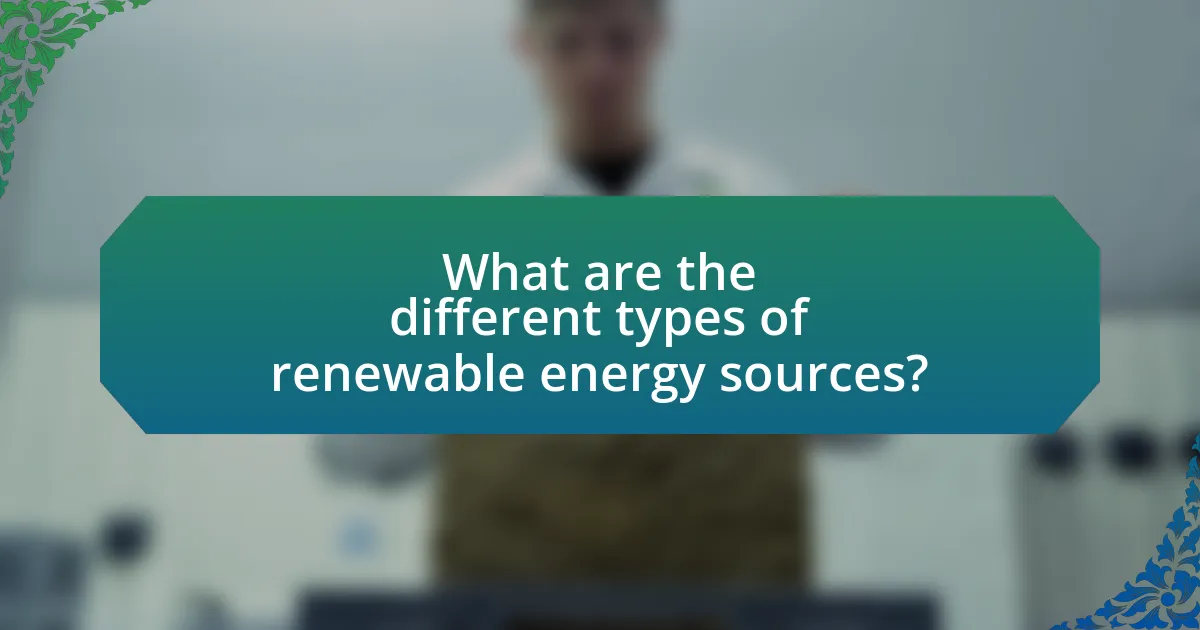
What are the different types of renewable energy sources?
The different types of renewable energy sources include solar energy, wind energy, hydroelectric energy, geothermal energy, and biomass energy. Solar energy harnesses sunlight through photovoltaic cells or solar thermal systems, while wind energy captures kinetic energy from wind using turbines. Hydroelectric energy generates power from flowing water, typically through dams. Geothermal energy utilizes heat from the Earth’s interior, and biomass energy derives from organic materials, such as plant and animal waste. These sources are essential for reducing greenhouse gas emissions and promoting sustainable energy practices.
How do solar, wind, and hydroelectric power contribute to diversification?
Solar, wind, and hydroelectric power contribute to diversification by providing multiple energy sources that reduce reliance on a single fuel type. This diversification enhances energy security and stability, as it mitigates risks associated with price volatility and supply disruptions in fossil fuels. For instance, according to the U.S. Energy Information Administration, renewable energy sources accounted for about 20% of total U.S. electricity generation in 2020, demonstrating a significant shift towards a more varied energy portfolio. By integrating these renewable sources, economies can better withstand market fluctuations and environmental impacts, ultimately fostering greater economic resilience.
What are the advantages of solar energy in economic resilience?
Solar energy enhances economic resilience by reducing dependence on fossil fuels and stabilizing energy costs. This diversification of energy sources mitigates the risks associated with volatile fossil fuel markets, which can lead to economic instability. For instance, a study by the International Renewable Energy Agency (IRENA) found that countries investing in solar energy can experience a 20% reduction in energy costs over time, contributing to greater economic stability. Additionally, solar energy creates jobs in installation and maintenance, further bolstering local economies and providing a buffer against economic downturns.
How does wind energy enhance energy security?
Wind energy enhances energy security by reducing dependence on fossil fuels and diversifying the energy supply. This diversification mitigates risks associated with fuel price volatility and supply disruptions, as evidenced by the International Renewable Energy Agency, which reported that countries investing in wind energy have seen a decrease in energy import reliance. Additionally, wind energy contributes to a more resilient grid by providing a stable and local energy source, which can be crucial during emergencies or natural disasters. The U.S. Department of Energy noted that integrating wind power into the energy mix can lead to a more reliable and secure energy system, ultimately strengthening national energy security.
What challenges do renewable energy sources face in promoting economic resilience?
Renewable energy sources face several challenges in promoting economic resilience, primarily including high initial investment costs, technological limitations, and regulatory hurdles. High initial investment costs can deter both public and private sector investment, as seen in the solar and wind industries, where upfront capital can be substantial. Technological limitations, such as energy storage and grid integration issues, hinder the reliability and efficiency of renewable energy systems, impacting their ability to provide consistent energy supply. Regulatory hurdles, including inconsistent policies and lack of supportive frameworks, can create uncertainty for investors and slow down the deployment of renewable technologies. These challenges collectively impede the potential of renewable energy to enhance economic resilience by limiting its scalability and integration into existing energy systems.
How do regulatory barriers impact renewable energy adoption?
Regulatory barriers significantly hinder renewable energy adoption by creating obstacles such as complex permitting processes, restrictive zoning laws, and inadequate incentives. These barriers can delay project timelines and increase costs, making it less attractive for investors and developers to pursue renewable energy projects. For instance, a report by the International Renewable Energy Agency (IRENA) indicates that streamlined regulations can reduce project development time by up to 30%, highlighting the importance of regulatory efficiency in promoting renewable energy. Additionally, countries with supportive regulatory frameworks, such as feed-in tariffs or tax credits, have seen much higher rates of renewable energy deployment compared to those with stringent regulations.
What are the financial challenges associated with renewable energy investments?
The financial challenges associated with renewable energy investments include high initial capital costs, fluctuating market prices, and uncertain regulatory environments. High initial capital costs can deter investors, as projects often require significant upfront funding; for instance, solar and wind installations can exceed millions of dollars. Fluctuating market prices for energy can impact the return on investment, as renewable energy sources compete with established fossil fuels, which can lead to volatility in revenue streams. Additionally, uncertain regulatory environments can create risks for investors, as changes in government policies or incentives can affect project viability and profitability. These factors collectively contribute to the financial hesitance surrounding renewable energy investments.
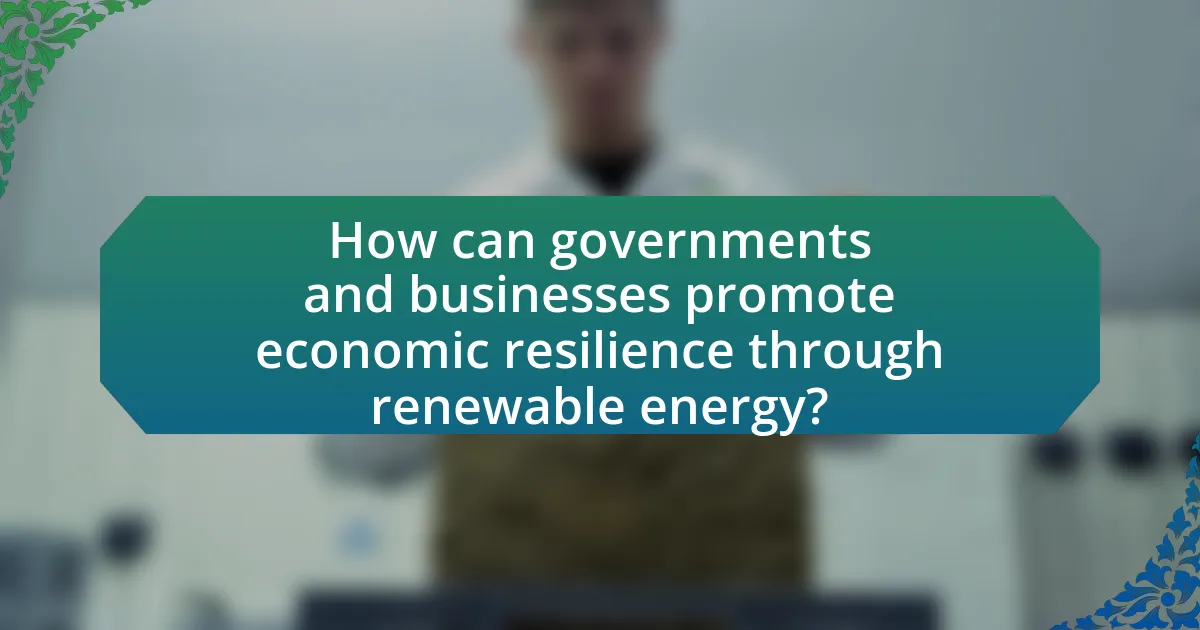
How can governments and businesses promote economic resilience through renewable energy?
Governments and businesses can promote economic resilience through renewable energy by investing in infrastructure, incentivizing clean energy technologies, and fostering public-private partnerships. Investment in renewable energy infrastructure, such as solar and wind farms, creates jobs and stimulates local economies, evidenced by the U.S. solar industry employing over 250,000 workers in 2020. Incentives like tax credits and subsidies for renewable energy projects encourage businesses to adopt sustainable practices, which can lead to a more stable economic environment. Additionally, public-private partnerships can facilitate innovation and reduce costs, as seen in the collaboration between governments and companies like Tesla in developing energy storage solutions. These strategies collectively enhance economic resilience by diversifying energy sources and reducing dependence on fossil fuels.
What policies can support the growth of renewable energy sectors?
Policies that can support the growth of renewable energy sectors include financial incentives, regulatory frameworks, and investment in research and development. Financial incentives such as tax credits and subsidies lower the cost of renewable energy projects, making them more attractive to investors. Regulatory frameworks, including renewable portfolio standards and feed-in tariffs, create a stable market environment that encourages the adoption of renewable technologies. Investment in research and development fosters innovation, leading to more efficient and cost-effective renewable energy solutions. For instance, the U.S. Department of Energy reported that federal tax incentives have significantly increased solar energy installations, demonstrating the effectiveness of such policies in driving sector growth.
How do subsidies and incentives affect renewable energy development?
Subsidies and incentives significantly accelerate renewable energy development by reducing financial barriers for investors and consumers. These financial supports, such as tax credits and grants, lower the cost of renewable technologies, making them more competitive with fossil fuels. For instance, the U.S. solar investment tax credit has led to a 167% increase in solar capacity from 2010 to 2020, demonstrating how targeted incentives can drive substantial growth in the sector. Additionally, studies show that countries with robust subsidy programs, like Germany and Denmark, have successfully increased their renewable energy share, achieving over 40% of their electricity from renewable sources. This evidence illustrates that subsidies and incentives are crucial for fostering innovation and expanding the renewable energy market.
What role do public-private partnerships play in renewable energy projects?
Public-private partnerships (PPPs) play a crucial role in renewable energy projects by facilitating investment, sharing risks, and leveraging expertise from both sectors. These collaborations enable governments to access private capital and innovative technologies, which are essential for developing large-scale renewable energy infrastructure. For instance, the International Renewable Energy Agency reported that PPPs have been instrumental in financing over 50% of renewable energy projects globally, demonstrating their effectiveness in mobilizing resources and accelerating project implementation.
What best practices can be adopted for successful renewable energy integration?
Successful renewable energy integration can be achieved through several best practices, including the development of robust grid infrastructure, implementation of energy storage solutions, and promotion of policy frameworks that support renewable energy adoption. A strong grid infrastructure ensures that energy generated from renewable sources can be efficiently transmitted and distributed, minimizing losses and enhancing reliability. Energy storage solutions, such as batteries, allow for the balancing of supply and demand, enabling the use of renewable energy even when generation is low. Furthermore, supportive policy frameworks, including incentives and regulations, encourage investment in renewable technologies and facilitate their integration into existing energy systems. These practices are validated by studies showing that countries with advanced grid systems and supportive policies, like Germany and Denmark, have successfully increased their renewable energy share while maintaining grid stability.
How can communities engage in renewable energy initiatives?
Communities can engage in renewable energy initiatives by forming local energy cooperatives that invest in solar, wind, or biomass projects. These cooperatives allow residents to collectively fund and manage renewable energy sources, thereby reducing reliance on fossil fuels and enhancing energy security. For instance, a study by the National Renewable Energy Laboratory found that community solar projects can increase local energy access and reduce energy costs by up to 20%. Additionally, communities can advocate for supportive policies and incentives from local governments, which can further facilitate the adoption of renewable energy technologies.
What strategies can businesses implement to diversify their energy sources?
Businesses can diversify their energy sources by investing in renewable energy technologies, such as solar, wind, and biomass. By integrating these technologies, companies can reduce reliance on fossil fuels and enhance energy security. For instance, according to the International Renewable Energy Agency, the global renewable energy capacity reached 2,799 gigawatts in 2020, demonstrating a significant shift towards sustainable energy solutions. Additionally, businesses can engage in energy purchasing agreements, such as power purchase agreements (PPAs), which allow them to secure long-term contracts for renewable energy at stable prices. This strategy not only mitigates price volatility but also supports the growth of renewable energy markets. Furthermore, companies can implement energy efficiency measures to reduce overall consumption, thereby decreasing the demand for traditional energy sources. These strategies collectively contribute to a more resilient energy portfolio, aligning with the goals of economic resilience through diversification.
What are the future trends in renewable energy and economic resilience?
Future trends in renewable energy and economic resilience include increased investment in solar and wind technologies, advancements in energy storage solutions, and the integration of smart grid systems. These trends are driven by the need for sustainable energy sources to combat climate change and enhance energy security. For instance, the International Renewable Energy Agency (IRENA) reported that global renewable energy capacity reached 2,799 gigawatts in 2020, with solar and wind accounting for the majority of new installations. Additionally, the transition to renewable energy is expected to create jobs and stimulate economic growth, as highlighted by a report from the International Labour Organization, which estimates that transitioning to a greener economy could create 24 million new jobs globally by 2030.
How is technology advancing the renewable energy landscape?
Technology is advancing the renewable energy landscape by enhancing efficiency, reducing costs, and enabling innovative energy solutions. For instance, advancements in solar panel technology, such as bifacial panels and perovskite cells, have increased energy conversion rates significantly, with some new models achieving efficiencies over 25%. Additionally, the development of smart grid technology allows for better integration of renewable sources, optimizing energy distribution and consumption. According to the International Renewable Energy Agency (IRENA), the cost of solar energy has dropped by 89% since 2009, making it one of the most affordable energy sources globally. These technological innovations not only improve the viability of renewable energy but also contribute to economic resilience by diversifying energy sources and reducing dependency on fossil fuels.
What emerging markets are leading in renewable energy diversification?
India and Brazil are leading emerging markets in renewable energy diversification. India has significantly increased its renewable energy capacity, aiming for 500 GW by 2030, with solar and wind energy being the primary contributors. Brazil, on the other hand, has a robust bioenergy sector, with over 40% of its energy matrix coming from renewable sources, primarily hydropower and ethanol. Both countries have implemented policies and investments that support the growth of diverse renewable energy technologies, positioning them as frontrunners in the global transition to sustainable energy.
What practical steps can individuals take to support economic resilience through renewable energy?
Individuals can support economic resilience through renewable energy by adopting energy-efficient practices, investing in renewable energy technologies, and advocating for supportive policies. Energy-efficient practices, such as using LED lighting and energy-efficient appliances, reduce overall energy consumption, which can lower utility costs and decrease reliance on fossil fuels. Investing in renewable technologies, like solar panels or wind turbines, not only contributes to personal energy independence but also stimulates local economies by creating jobs in the renewable sector. Advocacy for policies that promote renewable energy development, such as tax incentives or subsidies for clean energy projects, can further enhance economic resilience by encouraging broader adoption of sustainable practices. According to the International Renewable Energy Agency, the renewable energy sector employed over 11 million people globally in 2018, highlighting the potential for job creation and economic growth through individual actions in this field.
